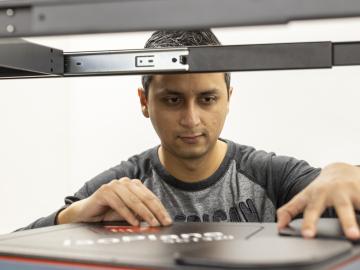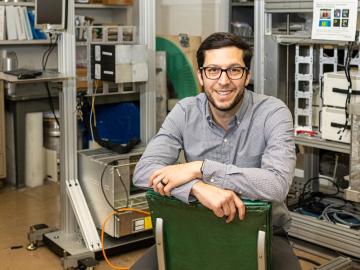
Filter News
Area of Research
- (-) Energy Science (55)
- (-) Nuclear Science and Technology (39)
- Advanced Manufacturing (4)
- Biology and Environment (18)
- Computational Engineering (1)
- Computer Science (7)
- Electricity and Smart Grid (3)
- Fuel Cycle Science and Technology (1)
- Functional Materials for Energy (1)
- Fusion and Fission (29)
- Fusion Energy (10)
- Isotope Development and Production (1)
- Isotopes (27)
- Materials (60)
- Materials for Computing (2)
- National Security (25)
- Neutron Science (18)
- Nuclear Systems Modeling, Simulation and Validation (1)
- Quantum information Science (1)
- Sensors and Controls (1)
- Supercomputing (52)
News Topics
- (-) Exascale Computing (2)
- (-) Grid (39)
- (-) Isotopes (6)
- (-) Machine Learning (7)
- (-) Nuclear Energy (41)
- (-) Physics (3)
- (-) Space Exploration (7)
- 3-D Printing/Advanced Manufacturing (82)
- Advanced Reactors (15)
- Artificial Intelligence (8)
- Big Data (5)
- Bioenergy (26)
- Biology (11)
- Biomedical (8)
- Biotechnology (4)
- Buildings (38)
- Chemical Sciences (14)
- Clean Water (8)
- Composites (17)
- Computer Science (27)
- Coronavirus (13)
- Critical Materials (9)
- Cybersecurity (9)
- Energy Storage (71)
- Environment (54)
- Fossil Energy (2)
- Frontier (2)
- Fusion (9)
- High-Performance Computing (6)
- Hydropower (3)
- Materials (35)
- Materials Science (29)
- Mathematics (2)
- Mercury (3)
- Microelectronics (1)
- Microscopy (8)
- Molten Salt (5)
- Nanotechnology (8)
- National Security (5)
- Neutron Science (15)
- Partnerships (12)
- Polymers (11)
- Quantum Science (2)
- Security (6)
- Simulation (4)
- Statistics (1)
- Summit (4)
- Transportation (66)
Media Contacts

Oak Ridge National Laboratory researchers working on neutron imaging capabilities for nuclear materials have developed a process for seeing the inside of uranium particles – without cutting them open.

A software package, 10 years in the making, that can predict the behavior of nuclear reactors’ cores with stunning accuracy has been licensed commercially for the first time.

The techniques Theodore Biewer and his colleagues are using to measure whether plasma has the right conditions to create fusion have been around awhile.

OAK RIDGE, Tenn., Feb. 19, 2020 — The U.S. Department of Energy’s Oak Ridge National Laboratory and the Tennessee Valley Authority have signed a memorandum of understanding to evaluate a new generation of flexible, cost-effective advanced nuclear reactors.
A team of scientists led by Oak Ridge National Laboratory found that while all regions of the country can expect an earlier start to the growing season as temperatures rise, the trend is likely to become more variable year-over-year in hotter regions.

Researchers at ORNL demonstrated that sodium-ion batteries can serve as a low-cost, high performance substitute for rechargeable lithium-ion batteries commonly used in robotics, power tools, and grid-scale energy storage.

To better determine the potential energy cost savings among connected homes, researchers at Oak Ridge National Laboratory developed a computer simulation to more accurately compare energy use on similar weather days.

As scientists study approaches to best sustain a fusion reactor, a team led by Oak Ridge National Laboratory investigated injecting shattered argon pellets into a super-hot plasma, when needed, to protect the reactor’s interior wall from high-energy runaway electrons.

If humankind reaches Mars this century, an Oak Ridge National Laboratory-developed experiment testing advanced materials for spacecraft may play a key role.

Jason Nattress, an Alvin M. Weinberg Fellow at the Department of Energy’s Oak Ridge National Laboratory, found his calling on a nuclear submarine.


